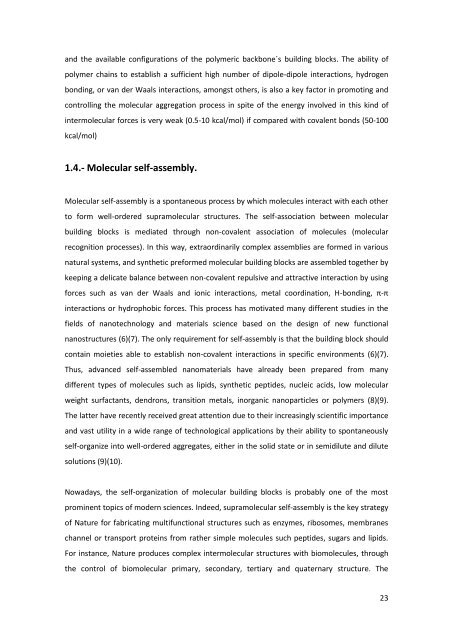Self-Assembly of Synthetic and Biological Polymeric Systems of ...
Self-Assembly of Synthetic and Biological Polymeric Systems of ...
Self-Assembly of Synthetic and Biological Polymeric Systems of ...
Create successful ePaper yourself
Turn your PDF publications into a flip-book with our unique Google optimized e-Paper software.
<strong>and</strong> the available configurations <strong>of</strong> the polymeric backbone´s building blocks. The ability <strong>of</strong><br />
polymer chains to establish a sufficient high number <strong>of</strong> dipole-dipole interactions, hydrogen<br />
bonding, or van der Waals interactions, amongst others, is also a key factor in promoting <strong>and</strong><br />
controlling the molecular aggregation process in spite <strong>of</strong> the energy involved in this kind <strong>of</strong><br />
intermolecular forces is very weak (0.5-10 kcal/mol) if compared with covalent bonds (50-100<br />
kcal/mol)<br />
1.4.- Molecular self-assembly.<br />
Molecular self-assembly is a spontaneous process by which molecules interact with each other<br />
to form well-ordered supramolecular structures. The self-association between molecular<br />
building blocks is mediated through non-covalent association <strong>of</strong> molecules (molecular<br />
recognition processes). In this way, extraordinarily complex assemblies are formed in various<br />
natural systems, <strong>and</strong> synthetic preformed molecular building blocks are assembled together by<br />
keeping a delicate balance between non-covalent repulsive <strong>and</strong> attractive interaction by using<br />
forces such as van der Waals <strong>and</strong> ionic interactions, metal coordination, H-bonding, π-π<br />
interactions or hydrophobic forces. This process has motivated many different studies in the<br />
fields <strong>of</strong> nanotechnology <strong>and</strong> materials science based on the design <strong>of</strong> new functional<br />
nanostructures (6)(7). The only requirement for self-assembly is that the building block should<br />
contain moieties able to establish non-covalent interactions in specific environments (6)(7).<br />
Thus, advanced self-assembled nanomaterials have already been prepared from many<br />
different types <strong>of</strong> molecules such as lipids, synthetic peptides, nucleic acids, low molecular<br />
weight surfactants, dendrons, transition metals, inorganic nanoparticles or polymers (8)(9).<br />
The latter have recently received great attention due to their increasingly scientific importance<br />
<strong>and</strong> vast utility in a wide range <strong>of</strong> technological applications by their ability to spontaneously<br />
self-organize into well-ordered aggregates, either in the solid state or in semidilute <strong>and</strong> dilute<br />
solutions (9)(10).<br />
Nowadays, the self-organization <strong>of</strong> molecular building blocks is probably one <strong>of</strong> the most<br />
prominent topics <strong>of</strong> modern sciences. Indeed, supramolecular self-assembly is the key strategy<br />
<strong>of</strong> Nature for fabricating multifunctional structures such as enzymes, ribosomes, membranes<br />
channel or transport proteins from rather simple molecules such peptides, sugars <strong>and</strong> lipids.<br />
For instance, Nature produces complex intermolecular structures with biomolecules, through<br />
the control <strong>of</strong> biomolecular primary, secondary, tertiary <strong>and</strong> quaternary structure. The<br />
23

















